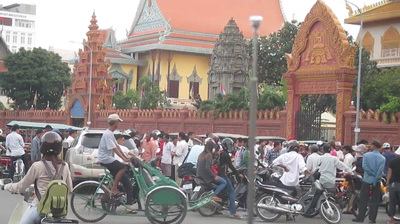| BANYAN BLOG |
banyan blog
|
I've been living in Cambodia for almost two years and early into my second year I finally got the nerve to drive here. We purchased a car, I obtained my license and bought insurance in case anything happened. In my first few weeks I was only brave enough to drive to some shops and restaurants by my house (usually less than a mile) and mostly took empty side streets. Each day I became more emboldened to drive farther from my comfort zone, albeit still short distances from home. I thought, “driving here is not so bad after all. I could do this”, but that was my nativity speaking based on the hand full of times of driving in off peak hours, short distances and with very little traffic. The Game of Frogger
When I was growing up, there was a popular video game in the U.S. called frogger. The concept of the game is that you the “frog” try to cross the street to get home safely. The key to the game is to not get killed by cars. Driving in Cambodia is a lot like the game of frogger, except that EVERYONE is the frog; cars, bikes, tuk-tuks, pedestrians, street carts, motos, cyclos, large construction trucks, etc. Everything is coming at you all at once and you have to avoid hitting them all. In the U.S. when a teenager turns 15 years old and 6 months, he or she is eligible to take drivers ED (driver’s education class) and can get their driver’s license at 16 years old (depending on the state). In drivers ED one key concept you learn is “right of way”. Right of way means when other traffic must yield to the motorist who has the “right of way” and allow them to proceed first. For example, legally speaking, cars that are going straight have the right of way to cars who are turning. If car A (car going straight) hits car B (car who tried to turn) then it would be car B’s fault for not obeying the right of way. While this concept should be universal in driving, the practice does not exist when driving in Cambodia. Most drivers will seem to have blinders on or blatantly ignore any approaching cars and creep up in your space to make their turn instead of looking both ways. Creeping is one of the most annoying and frustrating practices here. At any given intersection across Phnom Penh, law abiding motorists will go about their way cruising slowly towards their destination. Then all of a sudden a series of motos, tuk tuks, cars and other motorists will attempt to cross the street together as the oncoming traffic approaches. This leaves the oncoming traffic with no choice but to stop and let them creep further and further until they finally cross. This is what causes the majority of bottlenecks of traffic in the city. Everyone fights for an inch forward to creep. Then there are the drivers that run red lights blatantly in front of police, the drivers who cross the solid lines and drive towards oncoming traffic, drivers who weave in between two lanes either seemingly drunk or distracted by their cell phone conversation, the security guard/parking attendant who stops in the middle of a busy street to let their customer out of their parking spot (which is most of the time is a sidewalk since there are few “parking lots” or garages in the city) thereby holding up traffic, or the painfully slow street cart, cyclo or tuk tuk that goes at 5 miles an hour. Most of the time people don’t wear seat belts in cars and small children roam freely in the car oftentimes jumping back and forth between seats or sit in the drivers seat with the parents as if they were driving too. And of course there are many who ride motos that don’t wear helmets. What’s scarier is that as Phnom Penh accelerates development, large construction trucks scattered across the city streets are driven by mostly young men who probably don’t have the adequate experience and licensing to drive them, making it a ripe environment for inevitable disaster. The Way Things Are On the bright side, the best thing about driving in Phnom Penh is that everyone drives fairly slowly, and everyone is fairly patient. Honking is not considered rude (as it is in the states) but a necessity to warn other drivers that you are approaching. There is no “road rage” as there is in the states. No one shouts profanities at you or starts a fight if someone cuts them off. When I first started driving I would get so frustrated when someone didn’t look before they turned, or if they creeped right in front of my car and blocked my ability to pass. But now, I take it with a grain of salt and accept that this is the way things are here. I’ve learned to just let it go and make it home safely rather than to dwell on something I will never be able to change. Many of the traffic incidents and tragedies can be prevented if there was proper enforcement of traffic laws; stopping motorists who run red lights/go one one way streets, preventing large sized trucks on certain streets, stopping motos who don't wear helmets, and properly directing traffic so the practice of “creeping” stops. The “enforcers” often stop the wrong people at the wrong time. They selectively choose certain makes and models of cars or motos that look like “willing candidates” to stop for sometimes arbitrary reasons. Luxury cars rarely get stopped. What's even sadder is that while some motorists will stop, others will speed up or change lanes to avoid them. There is no chase, no sirens. The "enforcers" just wait for their next vehicle. The ones who try to do their jobs properly can’t because many people have very little respect for them to enforce the law, but those who were supposed to enforce the law has broken trust in the people they were supposed to protect. It’s a vicious cycle that gets repeated every day. What I've seen in driving in Cambodia is that chaos has order only if you have patience. I've realized that driving in Cambodia is not necessarily scary, but more so frustrating because it's so archaic for those who are used to rules and enforcement of them. Much like any country, or driving situation, there will be those who follow the rules and those who don't. That is human nature. But in the case of driving in Cambodia there are very little consequences for those who don't. In a way, driving in Cambodia is somewhat of a mirror of the country's social norms. Rules of hierarchy and rank play out on the roads everyday and the people have a generous amount of patience and understanding to tolerate it all. So, I will let the organized chaos surround me, accept what I cannot change, and try to approach driving in Cambodia with patience as possible. Take a deep breath and take it one day at a time. See the first story "Driving in Cambodia"
0 Comments
Leave a Reply. |
FEATURED INMOST POPULARThe Journey Archives
March 2017
follow |
© banyan blog 2013-2021
All Rights Reserved
All Rights Reserved









